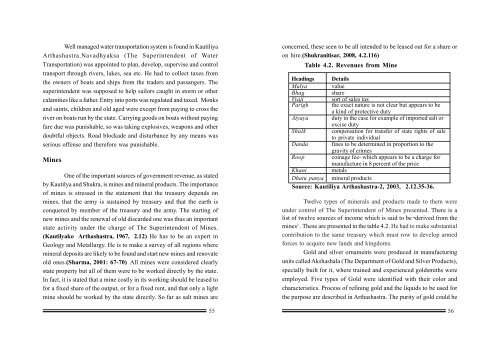Economics of Kautiliya Shukra and Brihaspati.pmd
Economics of Kautiliya Shukra and Brihaspati.pmd
Economics of Kautiliya Shukra and Brihaspati.pmd
You also want an ePaper? Increase the reach of your titles
YUMPU automatically turns print PDFs into web optimized ePapers that Google loves.
Well managed water transportation system is found in <strong>Kautiliya</strong><br />
Arthashastra.Navadhyaksa (The Superintendent <strong>of</strong> Water<br />
Transportation) was appointed to plan, develop, supervise <strong>and</strong> control<br />
transport through rivers, lakes, sea etc. He had to collect taxes from<br />
the owners <strong>of</strong> boats <strong>and</strong> ships from the traders <strong>and</strong> passangers. The<br />
superintendent was supposed to help sailors caught in storm or other<br />
calamities like a father. Entry into ports was regulated <strong>and</strong> taxed. Monks<br />
<strong>and</strong> saints, children <strong>and</strong> old aged were except from paying to cross the<br />
river on boats run by the state. Carrying goods on boats without paying<br />
fare due was punishable, so was taking explosives, weapons <strong>and</strong> other<br />
doubtful objects. Road blockade <strong>and</strong> disturbance by any means was<br />
serious <strong>of</strong>fense <strong>and</strong> therefore was punishable.<br />
Mines<br />
One <strong>of</strong> the important sources <strong>of</strong> government revenue, as stated<br />
by Kautilya <strong>and</strong> <strong>Shukra</strong>, is mines <strong>and</strong> mineral products. The importance<br />
<strong>of</strong> mines is stressed in the statement that the treasury depends on<br />
mines, that the army is sustained by treasury <strong>and</strong> that the earth is<br />
conquered by member <strong>of</strong> the treasury <strong>and</strong> the army. The starting <strong>of</strong><br />
new mines <strong>and</strong> the renewal <strong>of</strong> old discarded one was thus an important<br />
state activity under the charge <strong>of</strong> The Superintendent <strong>of</strong> Mines.<br />
(Kautilyako Arthashastra, 1967, 2.12) He has to be an expert in<br />
Geology <strong>and</strong> Metallurgy. He is to make a survey <strong>of</strong> all regions where<br />
mineral deposits are likely to be found <strong>and</strong> start new mines <strong>and</strong> renovate<br />
old ones.(Sharma, 2001: 67-70) All mines were considered clearly<br />
state property but all <strong>of</strong> them were to be worked directly by the state.<br />
In fact, it is stated that a mine costly in its working should be leased to<br />
for a fixed share <strong>of</strong> the output, or for a fixed rent, <strong>and</strong> that only a light<br />
mine should be worked by the state directly. So far as salt mines are<br />
55<br />
concerned, these seen to be all intended to be leased out for a share or<br />
on hire.(<strong>Shukra</strong>nitisar, 2008, 4.2.116)<br />
Table 4.2. Revenues from Mine<br />
Headings Details<br />
Mulya value<br />
Bhag share<br />
Vyaji<br />
Parigh<br />
sort <strong>of</strong> sales tax<br />
the exact nature is not clear but appears to be<br />
a kind <strong>of</strong> protective duty<br />
Atyaya duty in the case for example <strong>of</strong> imported salt or<br />
excise duty<br />
Shulk compensation for transfer <strong>of</strong> state rights <strong>of</strong> sale<br />
to private individual<br />
D<strong>and</strong>a fines to be determined in proportion to the<br />
gravity <strong>of</strong> crimes<br />
Roop coinage fee- which appears to be a charge for<br />
manufacture in 8 percent <strong>of</strong> the price<br />
Khani metals<br />
Dhatu panya mineral products<br />
Source: <strong>Kautiliya</strong> Arthashastra-2, 2003, 2.12.35-36.<br />
Twelve types <strong>of</strong> minerals <strong>and</strong> products made to them were<br />
under control <strong>of</strong> The Superintendent <strong>of</strong> Mines presented. There is a<br />
list <strong>of</strong> twelve sources <strong>of</strong> income which is said to be derived from the<br />
mines 1 . These are presented in the table 4.2. He had to make substantial<br />
contribution to the same treasury which must row to develop armed<br />
forces to acquire new l<strong>and</strong>s <strong>and</strong> kingdoms.<br />
Gold <strong>and</strong> silver ornaments were produced in manufacturing<br />
units called Akshashala (The Department <strong>of</strong> Gold <strong>and</strong> Silver Products),<br />
specially built for it, where trained <strong>and</strong> experienced goldsmiths were<br />
employed. Five types <strong>of</strong> Gold were identified with their color <strong>and</strong><br />
characteristics. Process <strong>of</strong> refining gold <strong>and</strong> the liquids to be used for<br />
the purpose are described in Arthashastra. The purity <strong>of</strong> gold could be<br />
56


